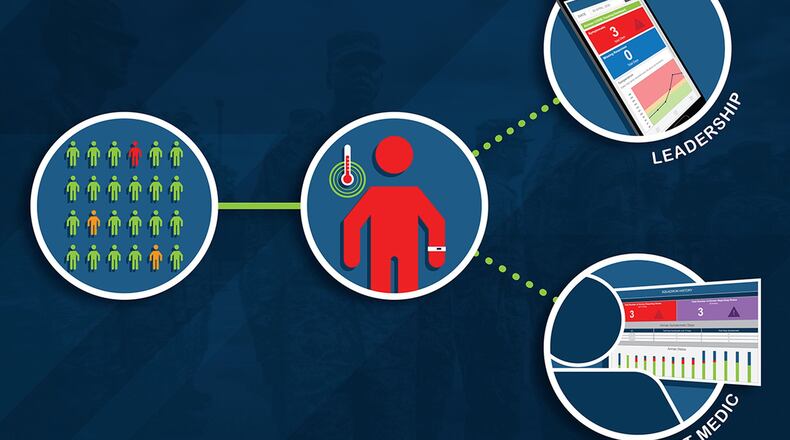“ADAPTS is an extremely flexible platform that we use to personalize and optimize the performance of our greatest asset, our Airmen,” said Dr. Adam Strang, lead scientist of AFRL’s Signature Tracking for Optimized Nutrition and Training team. “What makes ADAPTS so powerful is the ability to collect data from multiple sources seamlessly and then relay it rapidly to researchers, practitioners, and Airmen in meaningful ways.”
In the fight against COVID-19, it is the Smartabase component of ADAPTS that the AFRL team leveraged as a versatile tool for symptom monitoring. Strang said that during two-week quarantine periods, which are becoming common prior to and immediately following deployments, unit medical personnel can use the Smartabase mobile application and internet website to remotely track and monitor for COVID-19 symptoms and intervene if problems are detected.
In addition, units are able to view organizational-level dashboards and receive automated text and email alerts, providing continuous monitoring to help ensure the safety of Airmen. Strang and his teammates built and deployed this capability in Smartabase in less than 10 days and are looking to expand it with potential integrations with “smart” medical technologies such as Bluetooth thermometers.
Strang said this effort is an example of how the ADAPTS platform can quite literally be “adapted” in short order to serve specific needs at a specific time. He emphasized, however, that this type of use is only one small offshoot of the platform’s overall capabilities.
He explained that the concept for ADAPTS came from fellow researchers’ desires to better understand the human performance needs of the modern Airman.
“We scientists knew we needed tools to ingest, aggregate and visualize all the disparate human-performance data we were gathering if we were going to develop holistic tools and strategies to optimize human performance for an individual. For instance, our researchers are developing tools that can collect physiological data from wearables or other diagnostics such as blood tests and then provide automated recommendations for training adjustments. Without ADAPTS, those future capabilities would be impossible to realize.”
From the initial research application, ADAPTS has been rapidly advanced through close partnership with Air Force Special Warfare. Since January 2018, Dr. Strang and team have worked with leaders, medical staff and human performance support teams to field test and mature the system. The team is on schedule to equip every Air Force Special Warfare unit with ADAPTS by the end of 2021.
The Smartabase component of ADAPTS can collect data in several different ways: through manual input such as electronic surveys and forms, via a one-click desktop uploader for large database files, or through integration with third party devices or software. This level of data collection versatility helps further customize it to user needs and applications.
Strang said that the team has integrated into the platform automatic reports to track unit readiness, medical treatments, muscle soreness, daily wellness, sleep quality, injuries, and trainee motivation and performance. The functions for reports and visualizations are expanding as the platform is further developed and will include improved integrations with popular analytics software such as the open-source “R” platform and Microsoft’s Power BI. This expansion relies heavily on a balance of external collaborations with companies such as Fusion Sport and Oura, as well as internal developments by AFRL researchers.
In keeping with the sensitivities surrounding medical information, the Smartabase component of ADAPTS incorporates multi-layered security and data encryption, making it fully compliant with federal privacy provisions and suitable for use on government-owned systems.
Strang expects ADAPTS to continue to play a role in the identification and tracking of symptoms of COVID-19 for some time to come. It is also well-positioned to tackle any similar future performance and medical needs and will continue to be used to provide data for research and development.
“We are extremely pleased and fortunate to be able to provide the right tool at the right time for the safety of our Airmen,” he said. “Through continuous development and refinement by the user community, it will continue to address and capably serve the needs of future Airmen.”
About the Author
